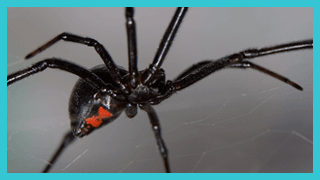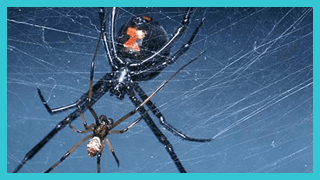Call for a Quick Estimate Today:
(702) 438-9708

 Common Name:
Common Name:
Black Widow Spider
Scientific Name:
Latrodectus mactans
Order and Family:
Theridiidae, Comb-footed Spiders
Recommended Pest Control Service:
Spider Pest Control
Description:
Male 1/8″ (3-4 mm), female 3/8″ (8-10 mm). Black. The Male’s abdomen elongated with white and red markings on the sides. Female’s abdomen almost spherical, usually with a red hourglass mark below or with 2 transverse red marks separated by black. Legs of males much longer in proportion to the body than those of females. Spiderling is orange, brown, and white, gaining more black at each molt.
Food:
Insects.
Web:
Irregular mesh with a funnel-shaped retreat, built-in sheltered spots.
Life Cycle:
Female rarely leaves web, stays close to egg mass, biting defensively if disturbed. The pear-shaped egg sac, 3/8-1/2″ (8-12 mm) wide, is pale brown. Female stores sperm, producing more egg sacs without mating. Spiderlings disperse soon after hatching. Some females live more than 3 years.
Habitat:
Among fallen branches and under objects of many kinds, including furniture, outhouse seats, and trash.
Range:
Massachusetts to Florida, west to California, Texas, Oklahoma, and Kansas; most common in the South.
Discussion:
Despite its reputation, this spider often attempts to escape rather than bite, unless it is guarding an egg mass. Males do not bite. After mating, the female often eats the male, earning the name “widow.”
WARNING: Of all spiders, the Black Widow is the most feared. The female’s venom is especially poisonous to people and pets.


Professional, Commercial & Residential Pest Control
Pet & kid friendly, Safe, Organic, Natural Pest Control